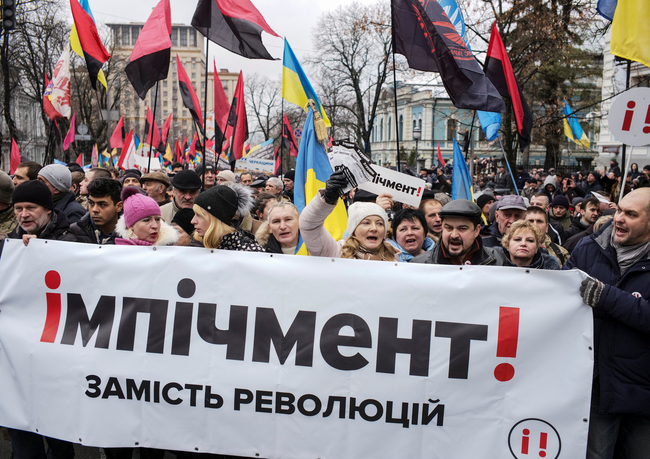Yet another march was held in Kyiv, with its leaders traditionally including Mikheil Saakashvili. Other marchers can be called the government’s opponents only conditionally, because some of them are still members of pro-presidential factions, such as Serhii Leshchenko or Mustafa Nayyem. In general, we have a strange situation: MPs hold protests and present demands at the walls of the Verkhovna Rada instead of doing the same within that body. At the same time, they fight the president while stubbornly remaining in his faction. Moreover, it is not just about criticizing Petro Poroshenko. They call for impeachment. We emphasize, it is not just about making changes to the law on impeachment, but about going ahead with the impeachment itself. Saakashvili has spoken quite clearly on that matter. One can even say that this is the only clear demand coming from him, because all his other demands sound like a lot of noise about the “fat cats government,” “criminals in power,” and so on. Saakashvili puts forward his slogan of impeachment with a direct hint that he is prepared to replace the incumbent head of state. Whether other participants of the protest scene share this opinion about the “alternative to Poroshenko,” remains an open question. It seems that each of them thinks about reaping election dividends for themselves.
While the previous procession was called the “March of the Outraged,” featured a banner with the word “impeachment,” and did gather several thousand participants indeed, then the present event, which was attended by as many people at least, was already called the straight-up “March for Impeachment.” And even the very word “impeachment” was far more frequent on the posters carried during the event.
It is clear that the people who attend these marches are mostly not interested in the subtleties of legislation and changes to it. Back on October 17, when they marched to the government quarter demanding political reform, the participants had little idea what the Anticorruption Court was, and were overall confused about the list of demands. That was the first attempt to “bring people into it.” Tents outside the Verkhovna Rada, blocked streets, and large presence of police (which then disappeared on Arsen Avakov’s orders and left the protesters alone and in a certain state of confusion) were an attempt to imitate the Maidan. But it turned out that the use of the word “Maidan” by certain politicians became a false start for these protests.

In general, the technologies of bringing people to rallies are simple and have long been in use. Representatives of the current government took an active part in such marches themselves before 2014. Rounding up or assembling a crowd is not hard. This requires a certain number of bribable people, a certain number of local activists of varying degrees of mental health, loudspeakers, flags, and a clear plan of pickets with predetermined slogans. The slogans themselves are easy to invent as well, as the theme of reform and the fight against corruption is a long-lasting one under our conditions. Thus, the cocktail for a picket, a rally or a march is ready, but it is still not a Maidan.








